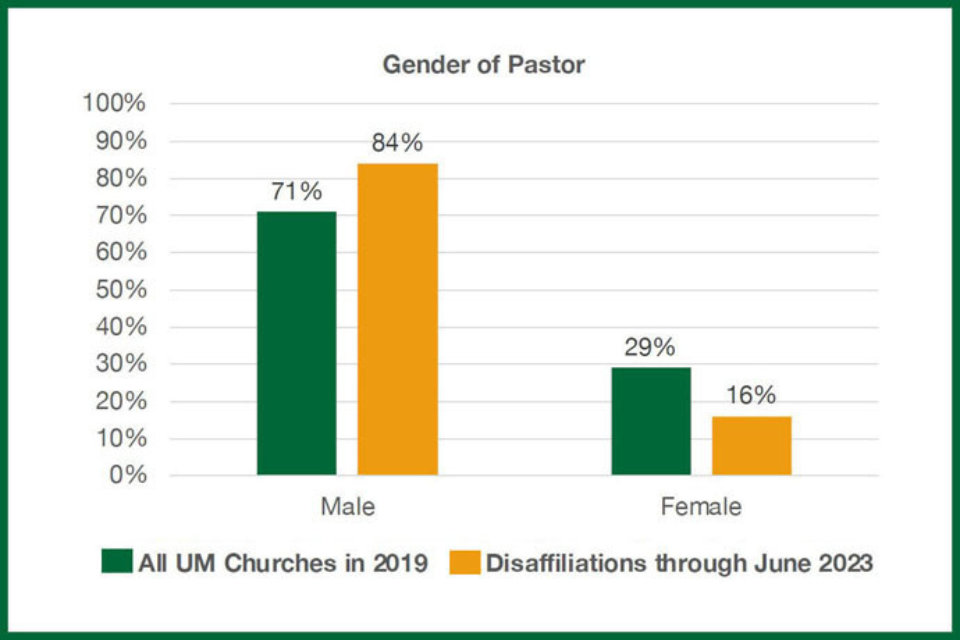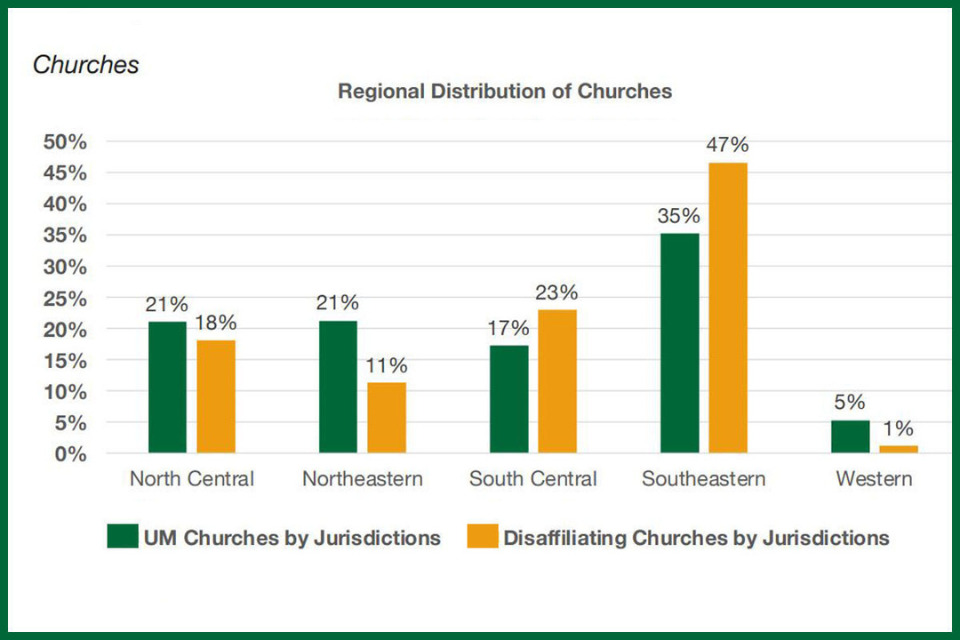Disaffiliations from The United Methodist Church have grown considerably and shifted geographically, according to a new study from the Lewis Center for Church Leadership. The Southeastern and South Central jurisdictions together still account for 70% of church departures — down from 84% in an earlier Lewis Center study.
SAM HODGES
UM News
Key points:
-
- The Lewis Center for Church Studies has done a second study comparing U.S. congregations disaffiliating from The United Methodist Church with those staying.
- Disaffiliation numbers have grown rapidly in 2023, and the new study finds the pool of departing churches is less dominated by the Southeastern and South Central jurisdictions.
- Departing churches remain more likely to be majority white and led by a male pastor than churches remaining United Methodist.
The numbers are way up, and the geography is shifting. Most other measures are about the same.
That’s the gist of a second report from the Lewis Center for Church Leadership comparing U.S. congregations disaffiliating from The United Methodist Church with those staying.
In late February, the Lewis Center published a study showing that departing churches were overwhelmingly from the denomination’s Southeastern and South Central jurisdictions and were more likely to be majority white and led by a male pastor than churches staying United Methodist.
The second study, out this week, analyzes updated and much larger disaffiliation numbers. It shows that the disaffiliation pool is still dominated by the Southeastern and South Central jurisdictions, but less so.
Mostly, the Lewis Center’s latest findings about the two groups of churches are in line with the first study.
“As we reported before, there are more similarities than differences comparing the cohort of disaffiliating churches with the total pool of all United Methodist churches,” writes the Rev. Lovett Weems Jr., senior consultant for the Lewis Center, in the new study.
Decades-long, intensifying conflict over homosexuality led the 2019 General Conference of The United Methodist Church to create a new policy whereby local churches in the U.S. can leave with their property.
Under Paragraph 2553 of the denomination’s Book of Discipline, churches can disaffiliate if they have a two-thirds vote of members to do so, followed by a majority vote of approval from their annual conference. They also must meet certain financial conditions.
Paragraph 2553 went into effect in 2019 and expires at the end of this year.
The Lewis Center — part of Wesley Theological Seminary in Washington — is known for its research on The United Methodist Church, including reports on clergy age trends.
In doing its studies on disaffiliation, the Lewis Center draws on data collected by the denomination’s General Council on Finance and Administration and uses as a base year 2019, when the departures were just beginning.
In other words, both remaining and departing churches are studied based on their characteristics in 2019, before COVID-19 hit.
“There are limitations to this approach, but we believe it serves to compare the two sets of churches at a time when we have sufficient data for almost all the churches (the total and those disaffiliating) and before the skewing of statistics that may have occurred during the heart of the pandemic,” Weems writes in the new report.
In 2019, the denomination had just over 30,500 congregations in the U.S. By the end of 2022, about 2,000 of those had left under Paragraph 2553.
For its February study, the Lewis Center compared the 2,000 to the remaining group.
The new study takes the same approach but reflects the quickening pace — and geographical spread — of disaffiliations, as many more annual conferences have met in special session or regular session this year to approve departures.
The Lewis Center identified 6,155 churches that disaffiliated between 2019 and the end of June 2023 — a tripling since the end of last year. UM News is doing its own count and shows 6,225 disaffiliations, including some since June.
In its first study, the Lewis Center found that 84% of departed churches were from two of the five U.S. jurisdictions — Southeastern and South Central.
But the new study, drawing on the larger pool of disaffiliations, shows those two jurisdictions now account for 70%.
The North Central, Northeastern and Western jurisdictions together had just 16% of church disaffiliations at the end of 2022. But the new study shows those three now make up 30%, with North Central by itself accounting for 18%.
That reflects big numbers of disaffiliations in certain North Central conferences in 2023, including West Ohio (172), East Ohio (237), and Indiana (174).
The Southeastern and South Central jurisdictions have continued to see a lot of church disaffiliations in 2023 — particularly the Southeastern. But they had a bigger percentage of the whole through the end of 2022.
The Lewis Center shared with UM News some statistics it did not include in the new report. They show that the Southeastern and South Central jurisdictions still have seen twice as many church disaffiliations as the other jurisdictions combined.
They also show that the Southeastern and South Central jurisdictions no longer have a majority of United Methodist churches in the U.S. That’s a change since 2019.
Disaffiliations under Paragraph 2553 will continue through the end of the year, but already the denomination is “less southern,” Weems said by phone.

Other characteristics identified in the first study were essentially confirmed by the second.
Male pastors led 71% of United Methodist churches in 2019, but led 83% of the first 2,000 churches disaffiliating, the February report showed.
The new report, drawing on the larger pool of disaffiliated churches, found 84% were led by men.
Both studies found that in 2019 elders led 37% of the churches that have gone on to disaffiliate under Paragraph 2553. Licensed local pastors, part-time and full-time, led about the same percentage.
The first report found that 97.3% of disaffiliating churches were majority white in membership as of 2019. The new report has that figure at 97.8%.
In 2019, 89.6% of all United Methodist congregations in the U.S. were majority white.
Majority African American congregations made up 7.2% of all United Methodist congregations in the U.S. in 2019 but made up just 1.4% of disaffiliating congregations as of June, the new report shows.
The United Methodist Church has long been a denomination with many small churches, and the studies reflect that.
The new study, for example, found that the median worship attendance for all United Methodist churches in 2019 was 38.
The remaining and disaffiliating churches are “very close” in their percentages of large, mid-size, and small churches, based on average worship attendance, both studies show.
Asked where disaffiliations have left The United Methodist Church as of this summer, Weems said: “Smaller, less southern, probably more diverse.”
He expects the Lewis Center will issue a third disaffiliation-related report after Paragraph 2553 sunsets at the end of the year.
“I’m sure we’ll just want to close the loop on this,” he said.
Last Updated on August 16, 2023

